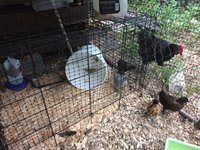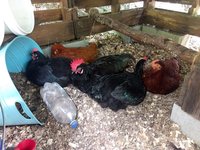FeatherstoneFrm
Songster
I've seen a lot of posts about introducing chicks to older birds but not much about introducing chicks to teens
My older birds are 17-18 weeks old, not yet laying. I have 2 cockerels and 3 pullets. I now have 4 pullets that are 5-6 weeks old. They have been in a large dog crate in the run for a week. The teens are mildly curious about them. I saw one of the pullets pull a couple of tail feathers out through the bars but my head cockerel pecked at her and pushed between her and the crate. I hope this means he is going to protect them when they are out in the run.
that are 5-6 weeks old. They have been in a large dog crate in the run for a week. The teens are mildly curious about them. I saw one of the pullets pull a couple of tail feathers out through the bars but my head cockerel pecked at her and pushed between her and the crate. I hope this means he is going to protect them when they are out in the run.
So how long should I keep them in the crate?. I plan to give them escape doors back into the crate, but not sure when and how. Should I stay with them for a few "visits" before leaving them out or just create the escape doors and let them venture out on their own? I would stay with them for a while at first just because I love to watch them and want to be sure every one behaves but I don't know what to expect. I'm probably overthinking again but that's me.
Thanks for any shared wisdom.
My older birds are 17-18 weeks old, not yet laying. I have 2 cockerels and 3 pullets. I now have 4 pullets
 that are 5-6 weeks old. They have been in a large dog crate in the run for a week. The teens are mildly curious about them. I saw one of the pullets pull a couple of tail feathers out through the bars but my head cockerel pecked at her and pushed between her and the crate. I hope this means he is going to protect them when they are out in the run.
that are 5-6 weeks old. They have been in a large dog crate in the run for a week. The teens are mildly curious about them. I saw one of the pullets pull a couple of tail feathers out through the bars but my head cockerel pecked at her and pushed between her and the crate. I hope this means he is going to protect them when they are out in the run.So how long should I keep them in the crate?. I plan to give them escape doors back into the crate, but not sure when and how. Should I stay with them for a few "visits" before leaving them out or just create the escape doors and let them venture out on their own? I would stay with them for a while at first just because I love to watch them and want to be sure every one behaves but I don't know what to expect. I'm probably overthinking again but that's me.
Thanks for any shared wisdom.








